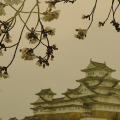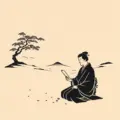Waka is a form of classical Japanese poetry that has been an integral part of Japanese literature and culture since ancient times. The term “waka” roughly translates as “Japanese poem” (although that might be a little laziness on the part of the original communicators) and refers to a variety of poetic forms that developed in Japan over many centuries. Despite being trapped in the grave of my own whiteness, I have studied and written waka myself. While I’m not fluent in Japanese (and thus largely restricted from writing in these forms) I find Japanese waka to be a powerful way to express emotions and ideas through concise, evocative language – even if I’m only reading in translation.
Contents
What is a Waka Poem?
A waka poem is a short Japanese poem, typically consisting of five lines with a total of 31 syllables arranged in a 5-7-5-7-7 pattern. This syllable count distinguishes waka from other forms of Japanese poetry like haiku (5-7-5) or tanka (5-7-5-7-7). The term waka came to encompass several different poetic forms, including chōka, tanka, sedōka, and bussokusekika.
Waka poetry flourished during the Heian period (794-1185) when it was an important form of artistic expression among the aristocracy. Poets like Ono no Komachi, Ki no Tsurayuki, and Izumi Shikibu were renowned for their masterful waka compositions. Many of their poems were included in imperial anthologies like the Kokin Wakashū, which helped establish waka as a prestigious literary form. The most famous anthology of Japanese poetry, to my mind, is the Hyakunin isshu, or One Hundred Poets, One Poem Each – there is a great translation available by Peter MacMillan, who also provides simple, interesting commentary on each of the poems and how he decided to translate them in certain ways.
What are the Different Types of Waka Poetry?
There are several different types of waka poetry, each with its own distinct characteristics:
Chōka:
Chōka, meaning “long poem,” is the oldest form of waka. It consists of alternating lines of 5 and 7 syllables, ending with an extra 7-syllable line. Chōka was often used to commemorate important public events or to praise the emperor. A famous example is Yamanoue no Okura’s “Dialogue on Poverty”:
“On Poverty”
How wretched is the life of the poor!
The cold wind blows through our thin clothes.
We shiver and shake in the freezing rain
While the wealthy feast in their mansions.
Is this the fate heaven has decreed?
Tanka:
Tanka emerged in the 8th century as a new form derived from chōka. It consists of five lines with 31 syllables in a 5-7-5-7-7 pattern (again, something that is often lost in translation). Tanka became the predominant form of waka during the Heian period. This tanka by Ono no Komachi exemplifies the form:
Colorful flower petals
Scatter in the spring breeze.
So too my yearning heart
Feels your absence most keenly
When the night grows still and deep.
Sedōka:
Sedōka is a rare six-line form consisting of two three-line stanzas, each with a 5-7-7 syllable count. The two stanzas are often written as a question and response. Here’s an example by an anonymous poet:
Will you wait for me
Until the cuckoo sings and
Summer is in bloom?Though spring passes by,
My love for you is constant
As the evergreen pine.
Other Forms:
Other less common forms of waka include bussokusekika (poems carved on Buddha’s footprints) and katauta (poem fragments). Together, these various forms showcase the diversity and adaptability of the waka tradition.
What are the Characteristics of Waka Poetry?
Waka poems share some common features that distinguish them from other forms of Japanese and Western poetry:
- Concision: Waka poems express deep feelings and complex ideas in very few words. Every word matters.
- Seasonal references: Many waka include kigo, words that evoke a particular season, to set the poem’s tone and mood.
- Wordplay: Waka often feature kakekotoba (pivot words) which have multiple meanings that add layers of depth.
- Emotional restraint: While waka convey strong emotions, they do so subtly through imagery and symbolism rather than direct statements.
- Nature themes: Waka frequently use natural imagery to explore human experiences and emotions metaphorically.
As translator and scholar Donald Keene explains in his book “Waka of Ancient and Modern Times”:
“The genius of waka lies in the ability to suggest a whole world in a brief space. A talented poet can express emotions that might take pages to describe in a novel or play in a single waka of 31 syllables.”
What is Haiku’s Relationship to Waka?
Haiku, one of the most well-known forms of Japanese poetry worldwide, has its roots in the ancient tradition of waka. While haiku is often celebrated for its simplicity and concision, it actually emerged from a longer, more complex form called renga.
From Waka to Renga
During the Heian period (794-1185), when waka was at its zenith, poets began experimenting with linking multiple tanka together into longer chains called renga. In a renga sequence, poets would take turns composing alternating 5-7-5 and 7-7 syllable verses that built upon the imagery and themes of the previous verses.
Renga became a popular form of collaborative poetry, with groups of poets gathering for renga parties that could last for hours or even days. The opening verse of a renga, called the hokku, set the tone for the entire sequence and was considered particularly important.
The Rise of Haikai
In the 16th century, a new style of renga emerged called haikai no renga, or “playful linked verse.” Haikai was characterized by its use of humor, wordplay, and references to everyday life, in contrast to the more serious and aristocratic tone of classical renga.
Matsuo Bashō (1644-1694), often considered the greatest haiku poet, was a master of haikai. He elevated the form by infusing it with a deep spiritual and philosophical sensibility. Bashō’s famous poem about a frog jumping into a pond is a prime example:
Old pond– a frog jumps in, sound of water.
The Emergence of Haiku
In the late 19th century, the poet Masaoka Shiki (1867-1902) advocated for the independence of the hokku as a stand-alone form. He coined the term “haiku” to refer to these individual verses, which were now being written and appreciated on their own merits.
Shiki and other reformers, such as Kawahigashi Hekigotō and Takahama Kyoshi, sought to modernize haiku by moving away from the wordplay and humor of haikai and emphasizing direct observation of nature and human experience. They also promoted the use of colloquial language and free subject matter.
This new style of haiku quickly gained popularity and became the dominant form of the genre in the 20th century. Poets like Taneda Santōka and Ozaki Hōsai continued to innovate and expand the possibilities of haiku.
Haiku in the Modern Era
Today, haiku is (for better or worse) a globally practiced form of poetry, with people around the world adapting the form to their own languages and cultural contexts – with greater or lesser results than the roots from which it grew. While modern haiku may not always adhere strictly to the 5-7-5 syllable pattern, (something which even most Japanese haiku don’t do in translation) they still aim to capture the essence of a moment with clarity and concision.
The legacy of waka lives on in haiku’s emphasis on seasonal references, natural imagery, and emotional restraint. As poet and critic Hasegawa Kai writes in “The Haiku Apprentice: Memoirs of Writing Poetry in Japan”:
“Haiku is the ultimate distillation of the Japanese poetic spirit, with its roots deep in the waka tradition. In just 17 syllables, a haiku can open up a whole world of feeling and insight, inviting the reader to share in the poet’s experience of the present moment.”
The Enduring Legacy of Waka
While waka is an ancient form, it continues to inspire modern poets in Japan and beyond. Waka’s influence can be seen in the development of later Japanese poetic forms like renga and haikai. And the waka tradition remains an enduring part of Japanese cultural heritage.
Studying classical waka can enrich any poet’s understanding of how to wield language with precision and power. It encourages us to distill our thoughts down to their essence. At the same time, the waka tradition reminds us that poetry is a living art, constantly evolving to reflect the experiences of each new generation.
I hope this overview has piqued your interest in exploring the fascinating world of waka poetry further. For those who want to dive deeper, I highly recommend “The Princeton Companion to Classical Japanese Literature” by Earl Miner, Hiroko Odagiri, and Robert E. Morrell as an authoritative resource on waka and its place in Japanese literary history – in addition to Peter MacMillan’s translation of One Hundred Poets, One Poem Each.
- Glossary of Japanese Poetry Terms - 26 February 2025
- What is Waka Poetry? - 23 May 2024
- How to Identify the Kigo in a Haiku: - 22 March 2024



